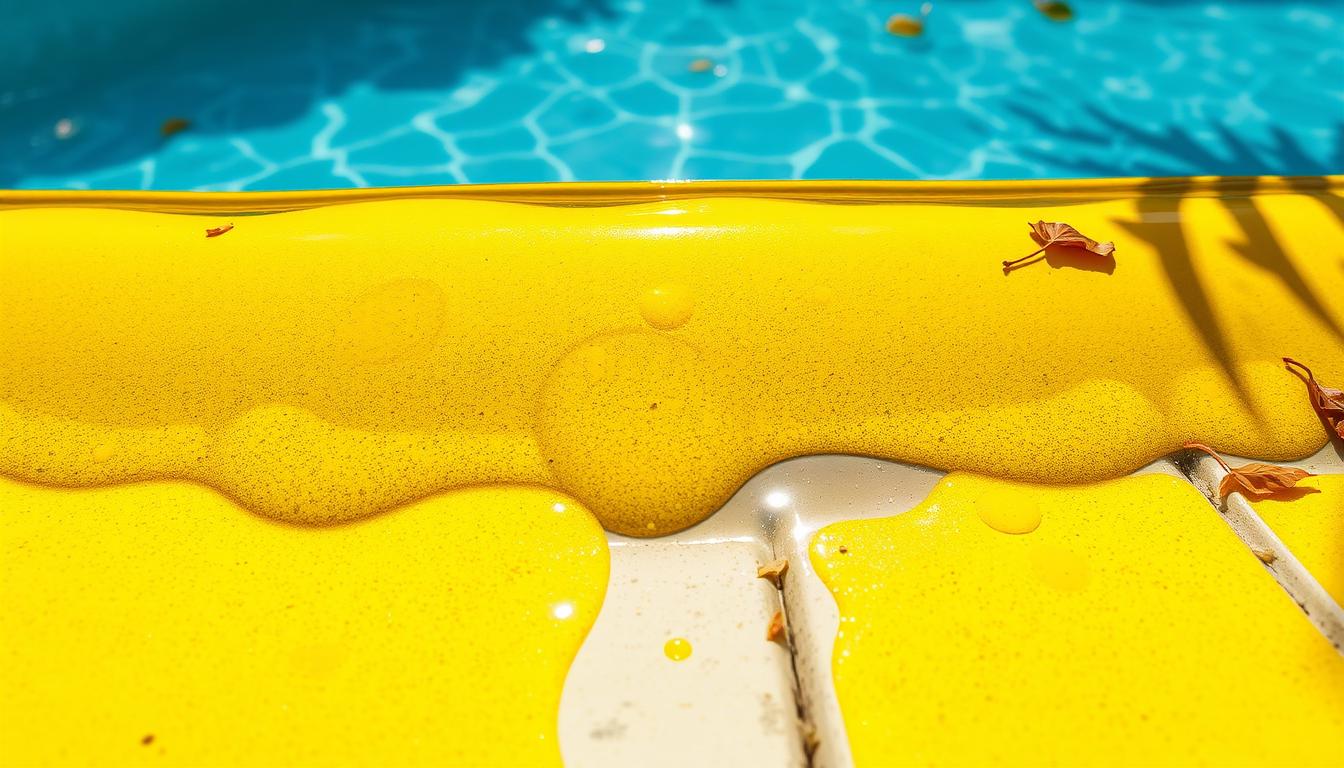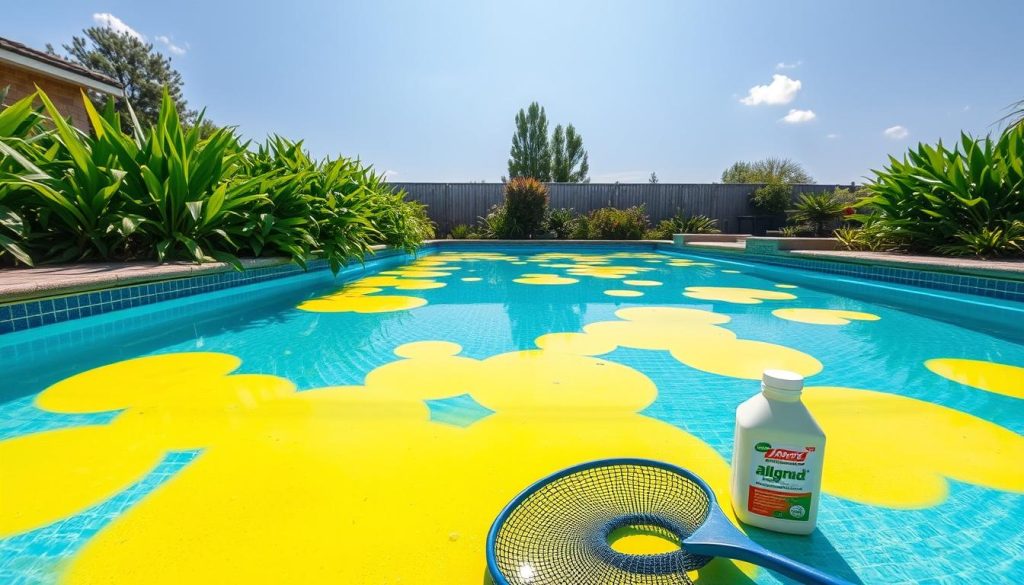
Pool owners often struggle with algae as summer approaches. Yellow algae, also known as mustard algae, can be a stubborn problem. This chlorine-resistant algae appears in shaded pool areas and is hard to remove.
It clings to pool surfaces and looks like a yellowish-brown slime. Unlike dirt or sand, yellow algae is a living organism that thrives in pools.
Yellow algae differs from other types and needs specific treatment. Understanding its growth factors is key to prevention. With the right knowledge, you can keep your pool algae-free all season.
Let’s explore yellow algae and learn how to identify it. We’ll also cover effective treatments to ensure your pool stays clean and healthy.
Understanding Yellow Algae in Swimming Pools
Yellow algae, also called mustard algae, causes problems in pools. It’s chlorine-resistant and harder to treat than green algae. Knowing yellow algae’s traits helps maintain a clean pool.
What is Yellow Algae and How Does it Differ from Other Types?
Yellow algae grows in pools, especially in warm climates. Unlike green algae, it thrives in dark corners. Yellow algae resists chlorine, making it tougher to remove.
Yellow algae has unique features. It’s chlorine-resistant and grows in dark areas. It’s common in warm climates near water bodies.
This algae clings to surfaces like walls, floors, lights, and pool accessories.
- Chlorine-resistant, making it more challenging to treat
- Can grow in dark areas of the pool, such as corners and crevices
- Often found in warmer climates, particularly near rivers, lakes, or other bodies of water
- Can cling to surfaces such as walls, floors, pool lights, ladders, and pool accessories
Factors Contributing to Yellow Algae Growth in Pools
Several factors cause yellow algae growth in pools. Poor maintenance and imbalanced chemistry are key issues. Inadequate filtration and environmental factors also play a role.
- Poor pool maintenance, cleaning, and water sanitation
- Imbalanced pool chemistry, particularly low chlorine levels
- Inadequate filtration and circulation
- Environmental factors such as nearby trees and warm, sunny weather
Proper water chemistry prevents yellow algae growth. Here are the ideal ranges:
| Parameter | Ideal Range |
|---|---|
| pH | 7.2 – 7.4 |
| Alkalinity | 60 – 120 ppm |
| Chlorine | 1.0 – 3.0 ppm |
Regular pool care helps prevent yellow algae. Run the pump 8-12 hours daily. Brush and vacuum weekly. Use algaecides and shock treatments.
Understanding yellow algae helps pool owners maintain a clean swimming environment. Take proactive steps to keep your pool healthy and algae-free.
Identifying Yellow Algae in Your Pool
Pool owners must watch for algae in their swimming pools. Yellow algae, or mustard algae, can be tough to spot and treat. Let’s explore how to identify yellow algae in your pool.
Visual Characteristics of Yellow Algae
Yellow algae looks like yellowish, yellow-green, or brown spots on pool surfaces. It often grows in shaded areas like corners, steps, and around fixtures. The algae feels slimy or velvety and resists brushing or vacuuming.
Key features of yellow algae include:
- Color: Yellowish, yellow-green, or brown
- Texture: Slimy or velvety
- Location: Often found in shaded areas of the pool
- Resistance: Stubborn and resistant to brushing or vacuuming
Distinguishing Yellow Algae from Other Pool Stains and Debris
It’s vital to tell yellow algae apart from other pool stains and debris. This ensures you use the right treatment. Some stains can look like yellow algae.
| Stain/Debris | Characteristics | Difference from Yellow Algae |
|---|---|---|
| Dirt and sand | Brown or tan in color, granular texture | Easily removed by brushing or vacuuming |
| Rust stains | Reddish-brown, often caused by metal objects | Not slimy or velvety, localized stains |
| Calcium deposits | White or grayish, rough texture | Not slimy, often found on tile or pool surfaces |
Yellow algae clings to surfaces and resists removal. Other stains and debris can often be brushed or vacuumed away easily. Look for the unique features of yellow algae to spot it.
Regularly inspecting your pool and familiarizing yourself with the visual characteristics of yellow algae can help you identify and address the problem early, preventing it from spreading and becoming more difficult to treat.
Knowing how to spot yellow algae helps you maintain a clean pool. You can act fast to prevent its spread and keep your pool healthy and algae-free.
What Does Yellow Algae Look Like in a Pool?
Yellow algae, or mustard algae, poses a challenge for pool owners in warm climates like Texas. It resists chlorine and spreads quickly if left untreated. Knowing its appearance helps you prevent and treat this stubborn problem effectively.

Common Appearances of Yellow Algae in Pool Water and Surfaces
Yellow algae can appear in several ways in your pool. Look for a yellowish tint in the water and yellow, yellow-green, or brown spots on surfaces.
Affected areas may feel slimy or slippery. Growth often concentrates in shaded spots like corners, crevices, and behind pool fixtures.
- Yellowish or mustard-colored tint in the water
- Visible spots and patches on pool surfaces, usually yellow, yellow-green, or brown in color
- Slimy or slippery texture on affected areas
- Growth concentrated in shaded areas of the pool, such as corners, crevices, and behind ladders or fixtures
Stages of Yellow Algae Growth and Their Visible Signs
Yellow algae growth becomes more visible as it spreads. Knowing the different stages helps you identify and address the issue quickly.
| Stage | Visible Signs |
|---|---|
| Early | Small, scattered spots on pool surfaces; slight discoloration in water |
| Intermediate | Larger patches of yellow or brown growth; increased water discoloration |
| Advanced | Extensive coverage of pool surfaces; significant water discoloration; slimy texture |
Spotting yellow algae early is key to preventing its spread. Regular maintenance and proper chemical balancing help keep your pool clean and healthy.
Weekly cleaning by professionals can also ward off yellow algae. This ensures your pool stays safe and enjoyable for your family.
Riverbend Sandler Pools offers expert services in Texas, including Dallas, Prosper, and McKinley, covering pool construction, repairs, winterization, and weekly maintenance to help prevent yellow algae formation in pools.
Effective Solutions for Treating Yellow Algae in Pools
Yellow algae in pools require a thorough approach. Clean all items that touched the algae, including swimsuits and pool toys. Brush pool surfaces to loosen algae, then vacuum to remove debris.
Maintain proper water chemistry to prevent yellow algae. Keep pH between 7 and 7.6, alkalinity between 60-120 ppm, and chlorine between 1.0-3.0 ppm. Shock the pool with high chlorine levels (10 ppm or higher) to kill algae.
Run the filter continuously to remove dead algae. Repeat the process until water chemistry balances and algae disappear. Use algaecides designed for yellow algae as extra protection.
Prevent yellow algae with consistent maintenance. Test water regularly, brush and vacuum the pool often. Use algaecide preventatively to control all types of algae growth.
Improve pool circulation and filtration. Run the filter longer in warm weather. Clean and disinfect pool accessories regularly to prevent algae reintroduction.
By following these steps, you’ll keep yellow algae at bay. Your pool will stay clean and enjoyable for everyone. Stay vigilant to ensure a healthy swimming environment.







